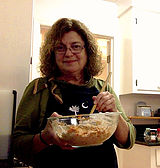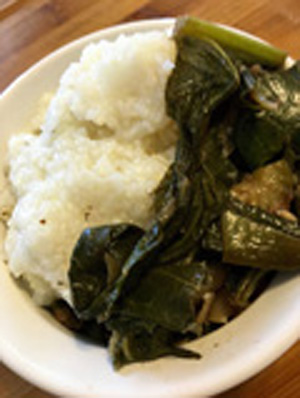Foodie Lit: A genre of novel and memoirs filled with food stories and recipes
Each month, I’ll share the magic of a good Foodie Lit read and one of its recipes.
Cooking and recipes in novels or memoirs take us into the mind of the character or narrator and brings us into the book’s kitchen to see, smell and share the lives within.
Here’s to cooking and reading together!
Susan
Amani’s River and Collard Greens!
In Amani’s River, an intense well-written historical novel by David Hartness, we are taken inside the mind of Aderito, a 10-year old American who travels with his father and mother to Mozambique. Aderito’s father wants to help his family, caught in the brutal violence of the Mozambique civil war, which raged from 1977-1992. Aderito becomes an unwilling child soldier in this civil war.
A quiet studious child, Aderito is transformed into a murderer after his kidnapping by the Renamo rebel forces, fighting against a repressive government forces. Both forces were accused later of war crimes. Beaten, starved and drugged, Aderito thinks, “This felt as if it were the end.” But it was not.
Memories of his former life fade. “Mixed with emotions, I felt the moral thing to do was tospare his life… However, the thing expected of me was to show my manhood and kill him for his sins. I couldn’t contemplate right from wrong, and so I closed my eyes and pulled the trigger.”
The Renamo commander controls Aderito’s life. “All I knew was that my new father said it (killing) was the best thing to do.” Trying desperately to fit into his new dystopia, Aderito knows that any of his actions or words can cause his own death. He lives between rage and killing, and a feeling that he has lost his soul.
One of the book’s most poignant scenes occurs when Aderito, on a killing raid in a hospital, hears a man calling his name. “Who was this man who knew my name?…I knew him but couldn’t remember.” Aderito found he was staring into the eyes of his father.
I asked David about this scene. How could Aderito not remember his own father? “Child soldiers are taken from a very young age. They are essentially brainwashed, and in many regards become dependent on the very people who captured them, much like anyone who is kidnapped. This brainwashing forces them to forget. The Renamo….captured the children either by force, homelessness or by paying the family. I know that may be hard to understand, but Renamo could provide food, clothes and a roof….which help in the brainwashing process.”
David Hartness brings us into a world that most cannot imagine. He writes, “I lived in Mozambique for three years (in the Peace Corps), and therefore I met many people who participated in the civil war and it was through their stories that I created my fictional account about the war…. I relied heavily on the people who lived through some of these atrocities.”
Why are children made into soldiers? David says, “The reason is simple and shocking. They are young and can easily be manipulated, and they eat less, therefore cost less.” Today, more than 300,000 child soldiers are exploited in such groups as ISIS, Boko Haram, Al-Qaida and radical Palestinian groups, such as Hamas. Schools and camps teach hatred and indoctrinate children with violent ideologies.
Some children are forced to kill, as we see in the unfolding narration in Amani’s River. Some are so indoctrinated with hate that they initiate violence on their own. Lest we think of this as fiction, on August 16 of this year, a child, some think 12 years old, attacked a Kurdish wedding party in Turkey, killing 27 and wounding 94. More than half of the victims themselves were children.
I asked David if the child soldiers he met had ever recovered from these horrors. “The former child soldiers I had met … had not fully recovered, and probably never will. Their entire life had been altered. They were forced to do unthinkable things. Everything that happened in the book happened to these children. I was either told this by them, recounting their experience, or reading accounts in old newspapers. I am not sure you can ever fully recover. These people wore scars on the outside and inside.”
Adopting a child from Mozambique, David and his son now live in the US, giving Luke more opportunities than he could have had in Mozambique.
David and I spoke about Mozambique’s typical food. Mozambique is the 15th poorest country in the world. The staple food for many Mozambicans is ncima, a thick porridge made from maize/corn flour and is similar to Southern grits. Collard greens, peppers, tomatoes and onions are often grown for home use and I made a dish by sautéing all together. Beans are also commonly used and are mentioned in Amani’s River. I added black beans and garlic for flavor to create a dish Aderito would have eaten.
Ncima, a corn meal porridge, and collard greens, peppers, tomatoes, onions, black beans and garlic, are mainstays of the diet in Mozambique. Those of us in the South are well acquainted with ncima, in the form of grits, and every Southern supermarket carries collard greens and the other vegetables in this dish.
Widely used by African slaves, as well as immigrants to the Carolinas from Scotland, what was once thought of as food for poor folks, is now known to be very healthy and graces many Southern tables. Kale, mustard greens or turnip greens may be used instead of or in combination with collard greens.
Collards and sautéed vegetables
2-3 tablespoons olive or vegetable oil
1 medium onion, diced
1 bell pepper, diced
2-3 garlic cloves, minced
2 medium tomatoes, diced
1 cup cooked black beans, drained and rinsed
1/4 cup white wine
1-16 ounce bag of collard greens, cut into thin strips or an equivalent amount of whole collards, washed, thick stems removed, and the leaves sliced
Salt and pepper to taste
- Heat olive oil in a large frying pan.
-
Add onion and sauté until onions begin to become translucent. Stir in bell pepper and garlic and cook for 2-3 minutes. Add tomatoes, beans and wine and stir together.
-
Add as many collard greens as will fit into the pan. As collards begin to shrink, add more until all of the collards are in the pan. Cook until vegetables are soft.
-
Season with salt and pepper.
Ncima
4 cups water
1 cup cornmeal
1/2 teaspoons salt
-
Pour water into a large pot. Over high heat, begin to bring to a boil.
-
Slowly add the cornmeal to the water, stirring continuously with a sturdy wooden spoon. Continue stirring until the mixture comes to a boil. Reduce heat and simmer until thickened.
-
The ncima should be very thick and smooth. Once the desired consistency is reached, turn off heat, cover the pot, and allow the ncima to stand for a few minutes before serving.

Susan is the indieBRAG Food Blogger – follow her indieBRAG Food Blog
- Pirates Rum Cake – “What would stories about pirates be without a bit of rum?”
- Seafood Chowder: Civil War Recipe – “With or without seafood, this was sure to satisfy any soldier!”
- Eggplant Relish. Growing up Jewish in Alexandria: The story of a Sephardic Family’s Exodus from Egypt – “Recipes? There were no recipes, just cooking!”
- Medieval Times and Chicken! – Using only ingredients available during Medieval Times!
Be sure to follow Susan at: everydayhappyfoods







Leave a Reply